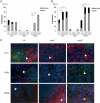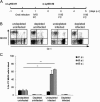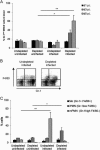Yersinia pseudotuberculosis efficiently escapes polymorphonuclear neutrophils during early infection
- PMID: 24379291
- PMCID: PMC3958004
- DOI: 10.1128/IAI.01634-13
Yersinia pseudotuberculosis efficiently escapes polymorphonuclear neutrophils during early infection
Abstract
The human-pathogenic species of the Gram-negative genus Yersinia preferentially target and inactivate cells of the innate immune defense, suggesting that this is a critical step by which these bacteria avoid elimination and cause disease. In this study, bacterial interactions with dendritic cells, macrophages, and polymorphonuclear neutrophils (PMNs) in intestinal lymphoid tissues during early Yersinia pseudotuberculosis infection were analyzed. Wild-type bacteria were shown to interact mainly with dendritic cells, but not with PMNs, on day 1 postinfection, while avirulent yopH and yopE mutants interacted with PMNs as well as with dendritic cells. To unravel the role of PMNs during the early phase of infection, we depleted mice of PMNs by using an anti-Ly6G antibody, after which we could see more-efficient initial colonization by the wild-type strain as well as by yopH, yopE, and yopK mutants on day 1 postinfection. Dissemination of yopH, yopE, and yopK mutants from the intestinal compartments to mesenteric lymph nodes was faster in PMN-depleted mice than in undepleted mice, emphasizing the importance of effective targeting of PMNs by these Yersinia outer proteins (Yops). In conclusion, escape from interaction with PMNs due to the action of YopH, YopE, and YopK is a key feature of pathogenic Yersinia species that allows colonization and effective dissemination.
Figures





References
Publication types
MeSH terms
Substances
LinkOut - more resources
Full Text Sources
Other Literature Sources

